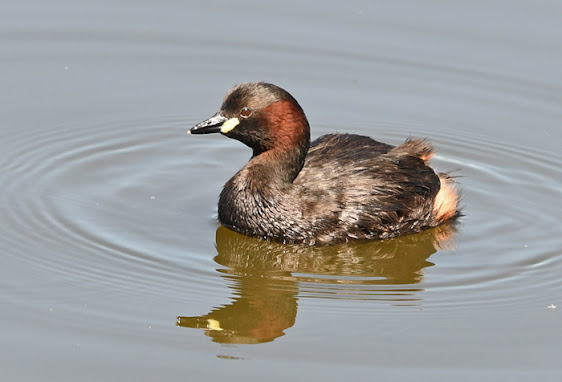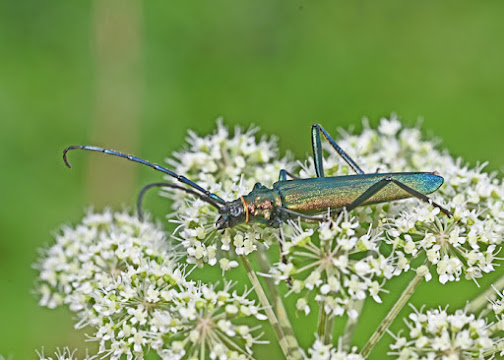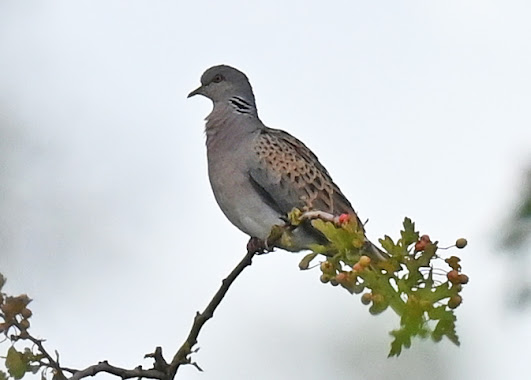The weather remained cool, unsettled and (most importantly for [lack of] photography) windy during the first week of August, but improved somewhat in the second and third weeks, with some warm, sunny days as high pressure tried, not very successfully, to take over. However, having missed out July and most of August, summer finally arrived at the end of the month. As the month went on I started to switch back from insects to birds, so once again I'll divide this page up into (1) invertebrates and (2) birds and other wildlife.
Invertebrates
As we move into late summer, here are a few reflections on how our butterflies have fared this year. The winners have definitely been Brown Argus, Holly Blue and Gatekeeper. Numbers of both generations of Brown Argus have been positively phenomenal. At times in early August, as I walked in the long grass of my local 'weedy field', they rose up in waves of 20-30 at a time. Bearing in mind that the second brood of Brown Argus hatches over a few weeks and that the average life span on the wing for this butterfly is only a few days, there must have been at least several hundred in this field alone. Large numbers of this butterfly were seen wherever I went, so this was not just a local phenomenon. Although the main food plant of the Brown Argus caterpillars is the Common Rock Rose, I believe that they must use other common wild flowers as well. In the spring I started to worry that the Holly Blue was going to have a poor year. I didn't see any locally until the middle of May but once they appeared, numbers of the first generation kept increasing well into June and there was only a small gap before an even larger second generation appeared. Although most were seen along hedgerows and near their food plants (Holly and Ivy), some were seen in grassland well away from bushes and, on more than one occasion, I mistook them for Common Blues in flight. Numbers fluctuate in cycles of 4-6 years due to the attentions of the grubs of a parasitic wasp - the wasp must be doing quite badly at the moment! Unlike the other two species, there is only a single generation of the Gatekeeper. However, very large numbers of this species have been on the wing since early July and at the time of writing (16 August) it is still one of the commonest butterflies in the Royston area.

Brown Argus Mating Pair, Church Hill, 9 August
Holly Blue, Royston, 10 August
With winners there have to be losers, and once again Small Tortoiseshell fits into this category. Very few were seen this year, with no over-wintering specimens being found by me and only a handful of 'fresh' butterflies seen in late June and July. Otherwise, most species had a roughly average kind of year. Chalkhill Blue numbers were below average, probably as a result of the poor July weather, but several hundred were still seen on The Heath. Very few were seen on the south facing slope of Church Hill (see my July post), but there were decent numbers on other areas of The Heath that are to the west of the Therfield Road.
I am always on the lookout for new or unusual species of invertebrates to photograph and then (the difficult bit) identify. I'm sure that I have misidentified flies as wasps or bees (and vice-versa). One species that I was able to identify (with the help of 'Brock') was an unusual Rhopalid bug, Corizus hyoscyami, which has apparently spread into our area fairly recently (image below).
Corizus hyoscyami, Therfield Heath, 10 August
A few more of my 'finds' are shown below. Some have yet to be identified to species level.
A common Hoverfly, Sericomyia sylentis, Royston, 10 August
Unidentified Ichneumon Wasp, Royston, 7 August
Tiny Bee (as yet unidentified), Royston, 7 August
Jersey Tiger Moths are becoming quite common in the Royston area, and have been seen in my garden on two occasions this summer. A male Banded Demoiselle dragonfly was seen near Royston Hospital on the 10th, whilst Common Blue Damselflies, Ruddy Darter, Black-tailed Skimmer and Emperor dragonflies were active at Phillup's Lake. Migrant Hawker dragonflies were seen just about everywhere as the month rolled on.
Often my trips on to The Heath yield little to write about. However, the visit to the east side (Old Rifle Range area) on the 17th provided lots of interest. The first of the second generation of Adonis Blues (12 males) were on the wing and I must have seen at least 20 Ruddy and (mainly) Common Darter dragonflies hanging about the isolated bushes, alongside a few hawker dragonflies. I was also able to add a new bush-cricket (Oak Bush Cricket) to my local patch list, making five in total (the others are Roesel's, Dark, and Speckled Bush Crickets and Long-winged Conehead). The Oak Bush Cricket is a common, nocturnal species which, despite its name, is not dependent on Oak Trees - just as well, as there are none on Therfield Heath.
Male Oak Bush Cricket, Therfield Heath, 17 August
Given the poor showings of Chalkhill Blues and first generation Adonis Blues on Church Hill, it was no surprise to find very few second generation Adonis Blues, with still no solution to the poor showings of these species here (see my July blog). However, Adonis Blue numbers grew on the eastern side of The Heath, with many females appearing towards the end of the month including an attractive 'blue' specimen (image below). I am currently studying and comparing the underwing markings of female Adonis and Chalkhill Blues, to see if there is a clear way of differentiating these two very similar species - watch this space!
Female Adonis Blue, Therfield Heath, 28 August
Birds and other Animals
August is, like July, a relatively quiet month for birds, with only Robins now singing regularly and many small birds taking the opportunity to rest and moult at the end of the breeding season. However, wader passage is already happening (although very few pass through the Royston area) and gulls and some raptors are also on the move. Indeed, during the last week of July and the first week of August I noted several small flocks of gulls (the vast majority Lesser Black-backed) flying west through the Royston area in the afternoons and early evenings, perhaps heading from a feeding site (Heydon Pig Farm??) to roost. I often see large flocks of gulls loafing or feeding in ploughed fields in late summer, but this year the harvest was late, presumably because of poor weather, so very few ploughed fields were available. On a showery afternoon on the 2nd I came across a mixed flock of Swallows and House Martins in a field near my house (see image). I guess that these were early migrants, given that the House Martins at Hatchpen Farm were still feeding young (although they were not seen there later in August). Ravens (either one or two together) were regularly seen in flight over or near The Heath during the first half of the month.

Swallows and (mainly) House Martins on wires, Royston, 2 August
There was some excitement locally, when a 'ringtail' harrier was found (Mike Ilett) at the beginning of the month in fields between Wallington and Baldock. Initially identified as a Montagu's Harrier, it might have been a young male Hen Harrier. Two Marsh Harriers (a smart juvenile and a moulting adult male), as well as a female Merlin, were seen in the same area and two Quail were sporadically heard singing. Hobbies were also present in what, following the 'demise' of the fields between Therfield Heath and Therfield village, has now become the Home Counties' 'go to' area for raptors. I visited the area on three occasions, seeing the Marsh Harriers and hearing the Quail, but missing out on the other raptors.
Given their late arrival in spring and the generally poor weather in July, I waited until 3 August to do my regular late evening Swift survey. Screaming parties were flying quite high and not coming down to roof-top level, suggesting that the birds would soon be departing. My counts are always very rough estimates, as it is impossible to accurately count the birds wheeling about in the sky, but I came up with an estimate of 80 birds, similar to that in 2022. The birds had departed for Africa a few days later.
Despite suffering from a long-term knee problem I decided to do an 8-9 mile walk around the villages of Therfield and Reed on the 15th. In doing so I established an unwanted record: only 28 bird species seen, the first time that I have ever seen fewer than 30 on a walk that I have done perhaps 150 times over the years! However, on the plus side I found at least six Little Grebes at Phillup's Lake including a family of four that didn't, for once, disappear as soon as I got my camera out, although they were rather distant ('record shot' below). At least seven Coot (five juveniles) were also seen here. Other highlights included at least ten Yellow Wagtails (including juveniles) seen in flight at Hatchpen Farm and a Little Owl, calling loudly near its nesting site on private land in Reed.
'Record Shot' of Little Grebe family at Phillup's Lake, Reed End, 15 August
On the 17th, as I walked up the path by the side of Royston Hospital, heading for the eastern side of The Heath (see above), a Marsh Harrier appeared over Greys Farm, heading towards the A10. Although distant, it appeared to be a female or juvenile (probably the former). I used to regularly see this species locally in the late summer and early autumn. Marsh Harriers don't breed in Hertfordshire: this bird had probably come from the population in the Cambridgeshire Fens. On the 25th a real rarity in the form of a Red-backed Shrike turned up on my local patch, at Reed End. Unfortunately, the bird was only seen and reported by one individual - it was nowhere to be seen when the 'hard core' Hertfordshire bird watching community turned up later in the day. I was at Titchwell on the 25th. I did look for the bird (which had been seen on my 'round the villages' route) on the following day without success although I did get a brief view of a Common Redstart, that had been seen by others looking for the shrike.
I found a Stonechat close to my home on the 28th, when the four locally common breeding species of warbler (Chiffchaff, Blackcap, Common and Lesser Whitethroats) were also seen, but there was little other evidence of bird migration through the local area. Common Lizards were seen on The Heath throughout the month, as was a large Common Toad, in my garden.
Stonechat, Royston, 28 August.






















